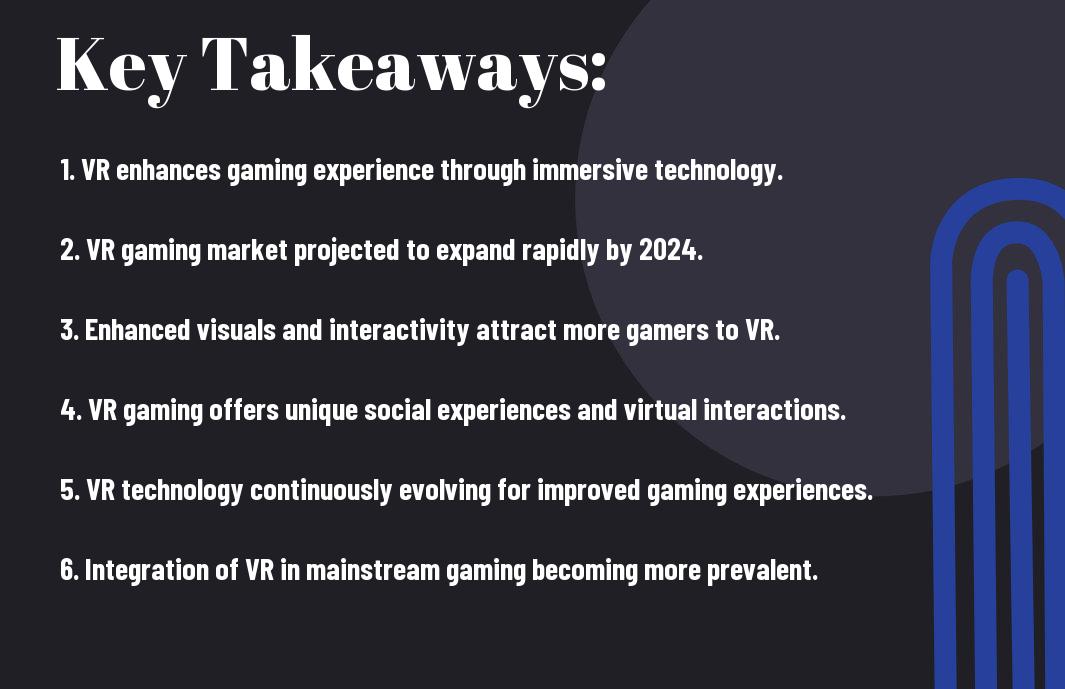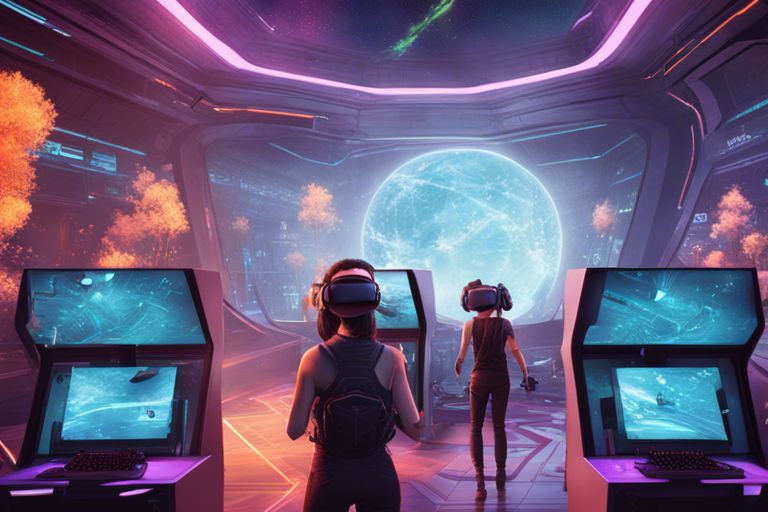Most gamers and tech enthusiasts in 2024 are witnessing a significant evolution in the gaming industry due to the widespread adoption of Virtual Reality (VR) technology. As VR continues to revolutionize the way games are played, it brings about immersive experiences that were once thought to be only a distant dream. From realistic graphics to innovative gameplay mechanics, the impact of VR on gaming is undeniable.

The Evolution of Virtual Reality in Gaming
Historical Perspective
One of the earliest instances of virtual reality in gaming can be traced back to the 1980s with the release of the first virtual reality headsets, which laid the foundation for the immersive gaming experiences we see today. While the technology was rudimentary compared to modern standards, it sparked a wave of innovation and experimentation that would shape the future of gaming.
Key Technological Milestones
Virtual reality has come a long way since its inception, with key technological milestones propelling its evolution. From the development of advanced motion tracking systems to the introduction of haptic feedback technology, each milestone has brought us closer to achieving truly immersive virtual experiences in gaming.
Virtual reality headsets have also become more accessible and user-friendly over the years, thanks to advancements in display technology and processing power. This has paved the way for broader adoption of virtual reality in gaming, making it a mainstream form of entertainment for gamers of all ages.
Virtual Reality Hardware
Now, as we explore into Virtual Reality (VR) hardware, it’s necessary to understand the crucial role it plays in shaping the immersive gaming experience. The hardware components are the backbone of any VR system, enabling users to step into a digital world and interact with it in ways never before possible. To learn more about the impact of VR on gaming, visit Impact of Virtual Reality on Gaming.
Head-Mounted Displays (HMDs)
With Head-Mounted Displays (HMDs), users are transported to alternate realities through high-resolution screens that cover their field of view. These devices are crucial for creating a sense of immersion by providing a visual experience that mimics real-world vision. With advancements in display technology, modern HMDs offer crisp graphics and low latency, reducing motion sickness and enhancing the overall gaming experience.
Motion Tracking and Input Devices
To enhance user interaction in virtual environments, motion tracking and input devices play a key role. These devices capture the user’s movements and translate them into the virtual world, allowing for realistic interactions and precise control. The seamless integration of motion tracking sensors and controllers enables users to navigate virtual spaces with fluidity and accuracy.
This level of control empowers gamers to engage with their digital surroundings in a way that blurs the line between reality and virtuality, creating a truly immersive experience. The evolution of motion tracking and input devices continues to push the boundaries of VR gaming, offering new possibilities for gameplay and interactivity.
Advancements in Haptic Feedback
With Advancements in Haptic Feedback, users receive sensory feedback that enhances their immersion in virtual environments. Haptic technology allows users to feel the virtual world through vibrations, textures, and even simulated forces. This sensory immersion adds a new layer of realism to VR experiences, making interactions more engaging and life-like.
This technological innovation not only enriches gameplay but also opens up avenues for applications beyond gaming, such as virtual training simulations and therapy programs. The potential for haptic feedback to revolutionize how users interact with VR content is immense, paving the way for more immersive experiences in the future.
Head-Mounted Displays, motion tracking, and haptic feedback are integral components of VR hardware that work together to create a seamless immersion for users. As technology continues to advance, these hardware elements will play a crucial role in shaping the future of gaming and other VR applications.
The Software Side: VR Game Development
Despite the rapid advancements in virtual reality technology, developing games for this immersive platform comes with its own set of challenges. Game developers entering this space need to carefully consider various factors to create compelling and enjoyable experiences for players.
Game Design Considerations for VR
Designing games for VR requires a fundamental shift in mindset from traditional 2D game development. Factors like player comfort, spatial awareness, and interaction mechanics play a critical role in shaping the overall game experience. Developers must design environments and gameplay that minimize motion sickness, utilize realistic physics, and provide intuitive controls to ensure players can fully immerse themselves in the virtual world.
Tools and Engines for VR Game Creation
Game development for VR is made more accessible through a variety of tools and engines designed specifically for creating virtual reality experiences. Platforms like Unity and Unreal Engine offer comprehensive support for VR development, providing a range of features such as VR-specific plugins, asset libraries, and optimization tools to streamline the creation process.
Plus, developers can take advantage of specialized hardware like VR headsets and controllers to further enhance the immersive capabilities of their games. These tools allow for precise tracking of player movements, enabling the creation of interactive experiences that blur the line between the virtual and physical worlds.
Emergent Genres in VR Gaming
Considerations for emergent genres in VR gaming are pivotal as developers explore new avenues for gameplay experiences. From immersive storytelling in narrative-driven adventures to the adrenaline rush of virtual sports competitions, the potential for VR gaming genres is vast and ever-evolving. Developers need to stay attuned to player preferences and technological advancements to capitalize on emerging trends and push the boundaries of what is possible in virtual reality.
User Experience in Virtual Reality Gaming
All Virtual Reality: Opportunities & Risks – Intenta Digital enthusiasts are aware that immersion and presence are crucial factors in creating a truly immersive virtual reality gaming experience. Immersion refers to the feeling of being deeply engaged in the virtual environment, while presence involves the sensation of actually being physically present in that environment. These elements are key to making players forget about the physical world around them and fully embrace the virtual one.
Immersion and Presence
Gaming in virtual reality has the power to transport players to new worlds and experiences like never before. The ability to look around, interact with objects, and move within the virtual space adds a new dimension to gameplay that traditional gaming cannot match. Developers are constantly striving to enhance immersion and presence to provide players with unforgettable and realistic experiences.
Interface and Usability Challenges
With the unique capabilities of virtual reality technology come interface and usability challenges. Navigating menus, handling in-game inventories, and controlling character movements can be more complex in a three-dimensional virtual environment. Developers must carefully design intuitive and user-friendly interfaces to ensure players can easily interact with the game.
Experience
When designing virtual reality games, developers must prioritize user experience by simplifying control mechanisms and providing clear instructions to avoid confusion. Testing different interface designs and receiving feedback from players are important steps in overcoming interface and usability challenges.
Health and Safety Considerations
The health and safety of players in virtual reality gaming is a paramount concern. Prolonged exposure to virtual reality can cause symptoms such as eye strain, motion sickness, and disorientation. Developers must implement measures to prevent these issues, such as incorporating regular breaks, offering adjustable settings, and providing guidance on safe usage practices.
The use of virtual reality technology also raises concerns about physical hazards, such as tripping over objects or colliding with real-world obstacles while immersed in the virtual space. Players should be encouraged to create a clear play area free of obstacles and be mindful of their surroundings while engrossed in the game. It is crucial for both developers and players to prioritize health and safety considerations to ensure a positive virtual reality gaming experience for all.

The Market Dynamics of VR Gaming
To Top 5 Virtual Reality Trends of 2024 — The Future of VR, the market dynamics of VR gaming are constantly evolving. Consumer adoption rates, business models, and the impact on traditional gaming industries are all significant factors that shape the landscape of virtual reality gaming.
Consumer Adoption Rates and Market Growth
To understand the market dynamics of VR gaming, it is crucial to analyze consumer adoption rates and market growth. The global VR gaming market is projected to experience substantial growth in 2024, driven by continuous technological advancements and an increasing demand for immersive gaming experiences. As more players enter the virtual reality space, consumer adoption rates are expected to rise, leading to a surge in VR hardware and software sales. This growth presents lucrative opportunities for game developers and hardware manufacturers to capitalize on the burgeoning market.
Business Models and Revenue Streams
With the maturation of the VR gaming industry, various business models and revenue streams have emerged to monetize virtual reality experiences. Subscription-based services, in-game microtransactions, and virtual goods sales are some of the prevalent models utilized by developers to generate revenue in the VR gaming ecosystem. Additionally, partnerships with hardware manufacturers and content licensing agreements offer alternative revenue streams for developers looking to diversify their income sources and maximize profitability.
Market dynamics dictate that staying innovative and adaptable to changing consumer preferences is crucial for sustained success in the VR gaming industry. As the market evolves, developers must continually refine their business models and revenue strategies to remain competitive and capitalize on emerging trends. By identifying market demands and aligning their offerings with consumer preferences, developers can carve out a profitable niche within the dynamic VR gaming landscape.
Impact on Traditional Gaming Industries
To fully grasp the impact of virtual reality on traditional gaming industries, it is vital to recognize the disruptive potential of VR technology. The integration of VR gaming experiences has transformed the way players engage with games, offering a level of immersion and interactivity that traditional gaming platforms struggle to replicate. This shift has prompted traditional gaming companies to explore VR integration and develop VR-compatible games to stay relevant in an increasingly competitive market.
Traditional gaming companies that embrace VR technology can unlock new revenue streams and appeal to a broader audience of gamers seeking immersive experiences. However, failing to adapt to the evolving landscape of VR gaming could pose a significant risk to the long-term viability of traditional gaming businesses. By strategically leveraging VR technology and innovating their offerings, traditional gaming industries can navigate the shifting market dynamics and secure their position in the future of gaming.
Social and Cultural Impact
Social Interaction within VR Games
After the emergence of virtual reality (VR) technology in gaming, social interaction within VR games has significantly evolved. Players can now immerse themselves in a virtual world where they can communicate, collaborate, and compete with others in real-time. The sense of presence and embodiment in VR environments has revolutionized the way gamers interact, creating a more engaging and authentic social experience.
Virtual Reality’s Role in Esports
Any the growth of virtual reality has had a profound impact on the world of esports. With the integration of VR technology, competitive gaming has reached new heights, offering players a more immersive and realistic gaming experience. VR esports tournaments and events have gained popularity, attracting both casual gamers and professional players. Impacting the esports scene, VR has opened up new possibilities for competitive gaming, pushing the boundaries of what is possible in virtual sports.
Culturally, the integration of VR in esports has brought a paradigm shift in how gaming is perceived and experienced. Virtual reality has not only enhanced the competitive aspect of esports but has also introduced a new dimension of spectatorship. Audiences can now engage with esports events in a more immersive way, blurring the lines between virtual and traditional sports. The cultural impact of VR in esports is reshaping the gaming industry and shaping a new era of interactive entertainment.
Educational and Training Applications within Gaming
Role of Virtual Reality technology in gaming has expanded beyond entertainment to include educational and training applications. VR simulations offer a hands-on and immersive learning experience, allowing users to practice real-life scenarios in a safe and controlled environment. Educational institutions and organizations are leveraging VR technology to enhance training programs in various fields such as medicine, aerospace, and engineering. The ability to simulate complex scenarios in a virtual setting is revolutionizing the way individuals learn and acquire new skills.
The Future and Potential of VR Gaming
Once again, we probe into Virtual Reality (VR) gaming and explore the exciting future it holds for gamers worldwide. As technology advances at a rapid pace, the potential for VR gaming to revolutionize the way we play and interact in virtual worlds is becoming more apparent.
Emerging Technologies and Their Implications
The emergence of technologies such as eye-tracking, haptic feedback, and improved motion tracking is set to enhance the immersive experience of VR gaming. These advancements not only offer more realistic interactions in virtual environments but also open up new possibilities for game developers to create innovative gameplay mechanics that were previously unimaginable.
Predictions for the Next Decade
Any discussion about the future of VR gaming would be incomplete without speculating on what lies ahead. With the rapid pace of technological advancement, it is likely that VR gaming will become more mainstream and accessible to a larger audience in the coming years.
Technologies have the potential to blur the lines between the physical and virtual worlds, offering gamers unparalleled immersion and experiences that were once confined to science fiction.
Ethical Considerations
Next, let’s consider the ethical implications of VR gaming. As the technology becomes more sophisticated and immersive, questions about data privacy, addiction, and the psychological impact of prolonged exposure to virtual environments need to be addressed.
To ensure the responsible development and adoption of VR gaming, industry players, policymakers, and researchers must collaborate to establish guidelines and regulations that protect users while fostering innovation in this exciting field.
Conclusion
As a reminder, virtual reality has significantly transformed the gaming industry by providing immersive experiences that were once only a dream. In 2024, the impact of virtual reality on gaming can be seen in the increasing popularity of VR games, the development of more innovative technologies, and the growing number of gamers embracing this futuristic technology. With advancements in VR headsets, controllers, and games, the future of gaming looks promising as virtual reality continues to push boundaries and redefine the way we play.
To summarize, the impact of virtual reality on gaming in 2024 is undeniable. It has revolutionized the way we experience games, offering players an unprecedented level of immersion and interactivity. As technology continues to evolve, we can expect even more exciting developments in the world of virtual reality gaming, making it an integral part of the gaming industry for years to come.
How Does Virtual Reality Technology Impact the "League of Legends" Meta in 2024?
In 2024, virtual reality technology has revolutionized the ultimate League of Legends meta. Players can now immerse themselves in the game like never before, experiencing heightened levels of strategy and teamwork. This advancement has led to a whole new level of competitiveness and innovation within the gaming community.
FAQ
Q: What is the impact of Virtual Reality (VR) on gaming in 2024?
A: Virtual Reality has significantly transformed the gaming industry by offering immersive experiences, realistic simulations, and interactive gameplay. In 2024, VR continues to push boundaries, providing players with a new level of engagement and excitement.
Q: How has Virtual Reality technology evolved over the years?
A: Virtual Reality technology has advanced rapidly, becoming more sophisticated and accessible. In 2024, VR headsets are lighter, more comfortable, and offer higher resolutions, leading to a more realistic and enjoyable gaming experience.
Q: What are some popular VR games in 2024?
A: In 2024, popular VR games include titles like “Half-Life: Alyx,” “Beat Saber,” “Resident Evil 4 VR,” and “Lone Echo II.” These games utilize VR technology to create immersive worlds and engaging gameplay experiences.
Q: How has Virtual Reality impacted the gaming industry in terms of innovation?
A: Virtual Reality has sparked innovation in the gaming industry, encouraging developers to explore new ideas and concepts. VR has led to the creation of unique gameplay mechanics, storytelling techniques, and design elements that would not have been possible with traditional gaming platforms.
Q: What are the challenges and opportunities of Virtual Reality in gaming?
A: Challenges in VR gaming include high costs, technological limitations, and concerns about motion sickness. However, VR also presents opportunities for developers to create groundbreaking experiences, reach new audiences, and push the boundaries of gaming innovation.
